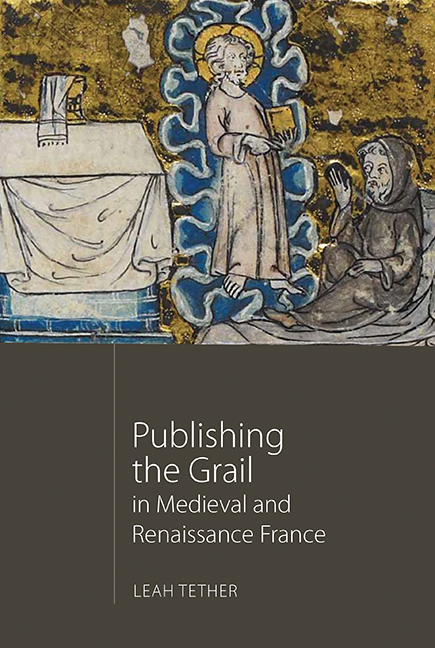Book contents
- Frontmatter
- Contents
- List of Illustrations
- Acknowledgements
- List of Abbreviations
- Miscellaneous Frontmatter
- Introduction: Grail Literature in France c. 1180–1530
- 1 Publishing in the Middle Ages and the Renaissance
- 2 Blurbing the Grail
- 3 Disclosing the Author
- 4 Re-packaging the Grail
- 5 Patronage and Promotion
- Conclusion
- Appendix: Timelines of Composition and Production
- Bibliography
- Index
- Arthurian Studies
- Frontmatter
- Contents
- List of Illustrations
- Acknowledgements
- List of Abbreviations
- Miscellaneous Frontmatter
- Introduction: Grail Literature in France c. 1180–1530
- 1 Publishing in the Middle Ages and the Renaissance
- 2 Blurbing the Grail
- 3 Disclosing the Author
- 4 Re-packaging the Grail
- 5 Patronage and Promotion
- Conclusion
- Appendix: Timelines of Composition and Production
- Bibliography
- Index
- Arthurian Studies
Summary
In this chapter, I explore the medieval and early-modern compilation of French Grail texts, viewing it as a method of ‘packaging’ and ‘re-packaging’ that is analogous, in respect of its purpose and effect, with the development of a modern publisher's list or series. Following an initial discussion of this model, I mostly adopt in this chapter a more data-led approach than used in previous chapters, whereby I set out and interrogate two key datasets in respect of the compilation of Grail literature in our previously delineated corpus of artefacts. The first dataset is found in Table 2, which sorts the corpus of artefacts, first, by the particular Grail text(s) contained within and, second, by their known (or assumed) date of copying. The second dataset is contained in Table 3, in which all of the artefacts are listed according to their chronological composition, thereby giving an overview of developments across the entire corpus. I take each of these datasets in turn, and underpin my enquiry with several key questions: are Grail texts compiled alongside contents with identifiable generic connections (at least from our modern perspective), for example, (pseudo-)historical, religious, literary, romance, verse or prose texts? Can any such generic connections be relied upon to have been recognisable to medieval audiences? What types of agency drive the compilatory context(s) of a given text? Can trends be seen in how Grail texts are interpolated, compiled and bound in volumes as time moves on? What does this suggest about changing perceptions of Grail texts, and the ways in which different medieval audiences might have categorised and contextualised them? I contend that the information contained in these two datasets is strongly indicative of there having existed a growing awareness of a form of ‘generic’ relationship between Grail texts between 1200 and 1530, one which became firmly established, and almost exclusively so, from the late thirteenth century onwards.
Medieval Compilation and Publishers’ Lists: Transcending Genre
In the past, it was something of a commonplace to suggest that medieval manuscript compilation was haphazard, often following no particular agenda. So-called ‘miscellanies’ were regularly held up as chief perpetrators thanks to their apparent lack of any cohering content or theme.
- Type
- Chapter
- Information
- Publishing the Grail in Medieval and Renaissance France , pp. 109 - 138Publisher: Boydell & BrewerPrint publication year: 2017

